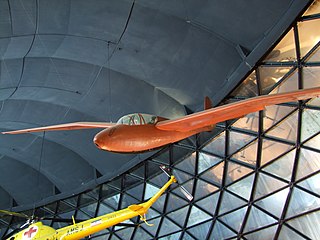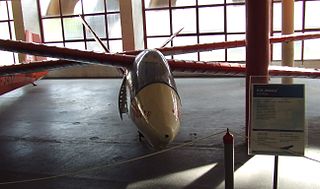
The Göppingen Gö 4 or Goevier is a German sailplane of the late 1930s used for training pilots. Its most notable features include side-by-side seating and dual controls, making the plane ideal for use as a trainer. It boasted average performance, compared to other gliders of the day, and was advertised as making the process of learning to fly sailplanes easier.

The Lo-100 is an aerobatic glider of classic wood and fabric construction well suited to amateur building methods. The designation Lo was bestowed by the designer Alfred Vogt in memory of his brother Lothar Vogt, with whom he had developed the predecessor model Lo-105 Zwergreiher. The first flight of the prototype took place in 1952 at the Klippeneck. An example is on display at the Gliding Heritage Centre.

The Antonov A-13 was a Soviet aerobatic sailplane flown in the 1950s and 1960s. It was a small, single-seat, all-metal aircraft developed from the A-11 which could optionally be fitted with that aircraft's longer-span wings. It was a mid-wing monoplane with a tadpole-like fuselage and a V-tail.

The SZD-6x Nietoperz was a single-seat tail-less experimental glider aircraft that was designed and built in Poland at Szybowcowy Zakład Doświadczalny in Bielsko-Biała in 1951. Only one example was constructed.

The SZD-12 Mucha 100 was a single-seat glider aircraft that was designed and built in Poland from 1953.

The SZD-17X Jaskółka L was a single-seat high-performance competition glider designed and built in Poland at Szybowcowy Zakład Doświadczalny in Bielsko-Biała in 1955.

The IS-5 Kaczka was a single-seat canard research glider designed and built in Poland from 1948.
The OMRE OE-1 was an experimental high performance sailplane designed and built in Hungary during 1950–1951.

The Rubik R-26 Góbé is a family of Hungarian shoulder-wing, two-seat training gliders that was designed by Ernő Rubik Sr., and produced by Auto-Aero. After its introduction the R-26 Góbé became the de facto training glider type in Hungary and is still used by many clubs for basic instruction.

The Hütter Hü 17, is a German high-wing, strut-braced, single-seat, utility training glider that was designed by brothers Ulrich Hütter and Wolfgang Hütter in the 1930s.

The HKS-1 was a German 19 19 m (62.3 ft) span high performance two seat sailplane, designed around 1950 to use recent advances in laminar flow airfoils. To avoid premature transition from laminar flow caused by surface interruptions, the HKS-1 dispensed with hinged ailerons, flaps and spoilers and replaced them with a flexible trailing edge. Two were built, setting several records.

The Bréguet Br 905 Fauvette is a single-seat, standard class, competition sailplane, designed and produced in France from the late 1950s. Some 50 were built but most remained grounded after a structural accident in 1969; a few remain airworthy.

The Ikarus Košava is a two-seat sailplane designed and built in Yugoslavia in the early 1950s. It won the 1954 World Gliding Championships in the two seat category and came second in the same event two years later.

The Cijan-Obad Orao is a competition single seat sailplane designed in Yugoslavia just after World War II, one of the most advanced of its type at the time. It flew in three World Gliding Championships, having greatest success at its first in 1950 when it reached third place.

The Ikarus Meteor is a long-span, all-metal sailplane designed and built in Yugoslavia in the 1950s. It competed in World Gliding Championships (WGC) between 1956 and 1968 and was placed fourth in 1956; it also set new triangular-course world speed records.
The Beatty-Johl BJ-2 Assegai was a single seat, high performance competition glider built in South Africa in the early 1960s. Only one was built; it was optimised for South African conditions and performed well there, winning two nationals and setting several records, but was less successful under European conditions at the 1965 World Gliding Championships.

The Rubik R-25 Mokány, in English: Plucky person and sometimes known as the R-25 Standard (class), is a Hungarian single seat Standard Class glider of all-metal construction, first flown in 1960. It was one of a series of similar aircraft designed by Ernő Rubik. Only one was built.

The Ciani EC 38/56 Urendo, or SSVV EC 38/56 Urendo is an Italian tandem-seat training glider from the 1950s. Four were built, one winning the Italian National Championships in 1959. Another, restored, still flies.
The Ciani EC.37/53 Spillo or SSVV EC.37/53 Spillo was a single seat competition glider designed and built in Italy in the 1950s. It had the highest aspect ratio wing of any wooden glider. Only one was built.

The Schleicher Ka-2 Rhönschwalbe is a tandem two-seat training glider designed and built in Germany, in 1952.

















